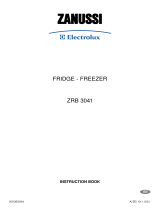
4
The instructions shall include the warnings:
WARNING!—Keep ventilation openings, in the appliance enclosure or in the built-in
structure, clear of obstruction.
WARNING!—Do not use mechanical devices or other means to accelerate the
defrosting process, other than those recommended by the manufacturer.
WARNING!—Do not damage the refrigerant circuit.
WARNING!—Do not use electrical appliances inside the food storage
compartments of the appliance, unless they are of the type recommended by the
manufacturer.
WARNING!—This appliance is not intended for use by persons (including children)
with reduced physical, sensory or mental capabilities, or lack of experience and
knowledge, unless they have been given supervision or instruction concerning use
of the appliance by a person responsible for their safety
WARNING!—Young children should be supervised to ensure that they do not play
with the appliance
WARNING!—The cord should be neither lengthened nor folded into coil during
operation. Moreover, it is forbidden that cord is kept close onto the compressor at
the back of the refrigerator, the surface temperature of which is quite high when
operating. Touching with it would deactivate the insulation or cause leakage for
electricity. Extension cord is not recommended to use. If the supply cord is damaged,
it must be replaced by the manufacturer, its service agent or similarly qualified
persons in order to avoid a hazard.
WARNING!—When disposing of the appliance, do so only at an authorized waste
disposal centre. Do not expose to flame.
WARNING!—Please keep the appliance away from substance, which can cause
ignition.
WARNING!—Before obtaining access to terminals, all supply circuits must be
disconnected.
WARNING!—Please remove the door before you dispose your refrigerator.
WARNING!—The fridge is only applied with power supply of single phase
alternating current of 220~240V/50Hz. If fluctuation of voltage in the district of
user is so large that the voltage exceeds the above scope, for safety sake, be sure
to apply A.C. Automatic voltage regulator to the fridge. The fridge must employ a
special power socket instead of common one with other electric appliances. Its plug




















